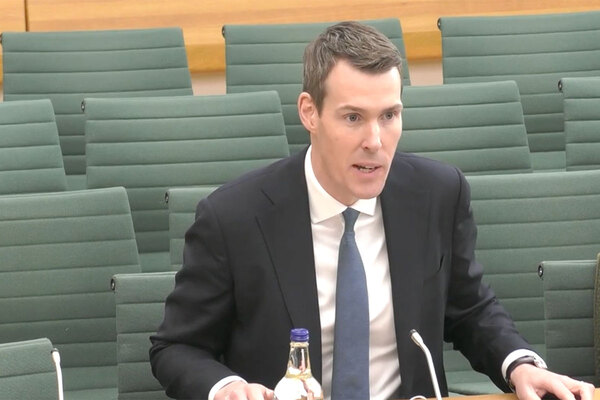You are viewing 1 of your 1 free articles
Government must adopt ‘genuinely’ cross-departmental approach to tackling homelessness, NAO says
The government must lead on adopting a “genuinely” cross-departmental approach to tackling homelessness, the National Audit Office (NAO) has said.
NAO, which published a value for money report on the effectiveness of the Department for Levelling Up, Housing and Communities (DLUHC)’s handling of homelessness since 2017, said this “might involve establishing a dedicated joint unit to oversee the implementation of the approach”.
It also recommended creating a long-term strategy for statutory homelessness.
Homelessness charity Crisis has also called for a cross-departmental unit to tackle all homelessness, similar to the one the previous Labour government had in place for rough sleeping.
Previous reports indicated that the new government intends to implement this, although it has not yet been confirmed.
The NAO report specifically looks into whether the department has a good understanding of the nature of homelessness, is delivering appropriate system leadership, and supports local authorities well.
The last report was published in 2017, six months before the Homelessness Reduction Act 2017 came into force.
The new report found that DLUHC, whose title has reverted back to the Ministry of Housing, Communities and Local Government under the new Labour government, has “significantly improved its understanding of the nature and causes of homelessness”, but that “gaps remain that make it harder to direct resources effectively”.
NAO found that while DLUHC has developed “much better homelessness data” and “stronger links with local authorities”, the government “still has no strategy or public targets for reducing statutory homelessness and DLUHC is falling behind on key programmes to improve housing supply”.
It said: “Until these factors are addressed across government, DLUHC will not be able to demonstrate that it is delivering optimal value for money from its efforts to tackle homelessness.”
The report highlighted that homelessness is now at the highest level since comparable data collection began in the early 2000s, and that local authority spending on homelessness services has more than doubled since 2010-11.
Councils spent £2.44bn on homelessness services in 2022-23, while 60% of their total gross expenditure on housing services (excluding that relating to their own housing) was used to deal with homelessness in 2022-23, up from 25% in 2010-11.
“Dealing with homelessness is creating unsustainable financial pressure for some local authorities. The situation has worsened since we last examined the issue in 2017,” NAO found.
It found that welfare reforms, including periodically capping and freezing the Local Housing Allowance (LHA), have reduced the amount of income in real terms that households can receive from benefits, while rents have increased faster than wages and LHA rates in much of the country.
“New housing supply in England is falling below the then government’s ambition, announced in 2017, of building 300,000 new homes each year by the mid-2020s.
“In particular, a lack of housing for social rent is a driver of homelessness, since households are instead pushed into the private rented sector which is typically more expensive and provides a less secure tenancy,” the report said.
NAO also found that the ending of a private rented sector assured shorthold tenancy is “one of the biggest drivers of homelessness”, accounting for around 23% of households owed a prevention or relief duty in quarter three of 2023-24.
On work to tackle homelessness specifically, NAO found that DLUHC’s data had improved significantly since 2017, but recommended publishing more granular data on households presenting as homeless and collecting more data on the quality of temporary accommodation.
The department does not have a strategy or published target for statutory homelessness, “which makes it more difficult to coordinate the government’s response”, NAO found.
On DLUHC’s support for local authorities, NAO found that central government funding arrangements for councils’ homelessness services “remain complex, fragmented and sometimes uncertain”.
“Local authorities told us that the short-term nature of funding makes it difficult to plan services strategically, optimise their use of temporary accommodation and spend the allocated funding in the given timeframe,” it said.
Recommendations in the report include that the department should explore how it can provide local authorities “greater predictability of funding for homelessness” within a spending review period.
It should consider how it can support local authorities to focus more on homelessness prevention and consider how the quality of B&B accommodation could be improved.
NAO said the department should establish a way for councils to more easily understand innovative practice and potential solutions in homelessness services from other authorities.
It should also publish data on repeat homelessness and out-of-area temporary accommodation placements.
The report added: “As part of the next spending review, and to support a cross-cutting approach to tackling homelessness, we recommend that HM Treasury should review and seek to simplify cross-departmental funding for homelessness [and] consider ways to incentivise government departments to support homelessness prevention, to deliver better outcomes and improved value for money.”
A spokesperson for the Ministry of Housing, Communities and Local Government said: “Homelessness levels have sky-rocketed and too many families are living in temporary accommodation.
“We will take the action needed to tackle this issue and develop a long-term, cross-government strategy working with mayors and councils to put Britain back on track to ending homelessness.
“We welcome the NAO’s report, which shines a light on this important issue and will consider their recommendations as we develop our strategy.”
Crisis described the situation as a “scandal”.
Francesca Albanese, executive director of policy and social change at Crisis, said: “With homelessness at record levels, and the numbers expected to rise even more, we can’t delay progress to tackle this scandal any longer.
“A perfect storm of sky-high rents, a dire shortage of affordable housing and increased living costs are pushing more and more people to the brink. While councils are doing all they can to support struggling households, operating under this level of pressure is not sustainable.”
Inside Housing’s investigation into in-person homeless approaches to councils found that some only offer online or via the phone services, leaving people struggling to get help.
Ms Albanese said it is “critical” that the Westminster government “urgently establish a homelessness unit to work across all departments”.
“Alongside this, we need clear plans on how it will deliver the social housing we need and properly fund local authorities, so that everyone can have a safe and stable home,” she added.
London Councils, the cross-party group representing local authorities in the capital, said the report demonstrates the “urgent need for a new approach”.
Grace Williams, executive member for housing and regeneration at London Councils, said homelessness a “national emergency”, but is “not inevitable”.
She added: “As this report clearly demonstrates, government policy could be far more effective in tackling homelessness and getting to grips with its underlying causes.
“Better co-ordination across government departments, greater housing security, sufficient funding for councils and more investment in building affordable homes are key to turning the situation around.”
Ms Williams stated that London boroughs are “determined to work with the new government and the mayor of London in tackling this crisis”, adding that “there is not a moment to waste”.
In February, the group revealed that London boroughs’ spending on temporary accommodation grew by almost 40% last year, reaching £90m per month in 2022-23.
London Councils’ policy priorities for addressing homelessness include boosting homelessness prevention grant funding and removing the January 2011 cap on LHA payable for temporary accommodation in housing benefit subsidy.
Councils are losing millions of pounds in subsidy for temporary accommodation because of rules agreed more than a decade ago.
Local authorities pay the cost of that housing benefit upfront and then are paid back by the Department for Work and Pensions through subsidy arrangements.
Households receive the full housing benefit they are entitled to, but the amount the council can claim back for temporary accommodation is limited to 90% of the LHA rates from January 2011.
The NAO report highlights that the subsidy gap is a “major concern for councils”. In April it emerged that Bristol City Council was projecting a £17m gap for 2024-25, while the rules led to a £5.9m loss for Sheffield City Council in 2022-23.
London Councils also called for increased capital investment for housing acquisitions, which could help councils address the shortage of temporary accommodation, particularly through acquiring homes being sold by private landlords as they exit the market.
It also called on the government to bring forward a cross-departmental strategy to reduce homelessness.
John Glenton, executive director of care and support at housing association Riverside, said more money must be spent on prevention.
He said Riverside has worked with Sefton Council on a homelessness prevention scheme “with a 96% success rate”.
“By placing families in social housing with a dedicated support worker, we have saved the council £1.2m over four years – a 75% saving on the cost of putting those families in temporary accommodation,” he explained.
He added that by comparison, putting families in temporary accommodation is “creating a humanitarian crisis behind closed doors” and a “financial crisis” in town halls and city halls across England.
Mr Glenton said the landlord thinks that the NAO’s call for an overarching homelessness strategy “does not go far enough”.
“Having a joined-up national approach to both housing and homelessness means councils can learn how to partner with housing associations to better use existing local housing supply to get families out of temporary accommodation, as we have done in Sefton.
“However, we desperately need to build more social housing to provide a long-term, sustainable solution to the housing and homelessness crisis facing the nation,” he said.
Sign up for our homelessness bulletin
Already have an account? Click here to manage your newsletters












